Related Research Articles
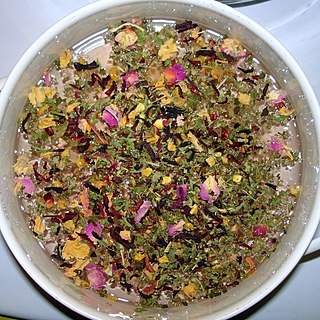
Herbal teas, also known as herbal infusions and less commonly called tisanes, are beverages made from the infusion or decoction of herbs, spices, or other plant material in hot water. Oftentimes herb tea, or the plain term tea, is used as a reference to all sorts of herbal teas. Many herbs are used in herbal medicine. Some herbal blends contain actual tea.
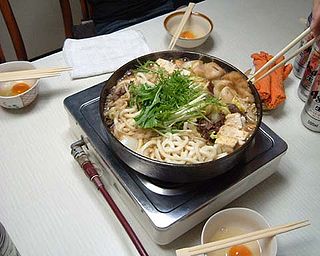
Nabemono, or simply nabe, is a variety of Japanese hot pot dishes, also known as one pot dishes and "things in a pot".
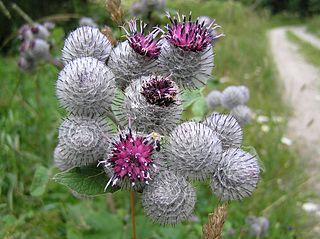
Arctium is a genus of biennial plants commonly known as burdock, family Asteraceae. Native to Europe and Asia, several species have been widely introduced worldwide. Burdock's clinging properties, in addition to providing an excellent mechanism for seed dispersal, led to the invention of the hook and loop fastener.

Simmering is a food preparation technique by which foods are cooked in hot liquids kept just below the boiling point of water and above poaching temperature. To create a steady simmer, a liquid is brought to a boil, then its heat source is reduced to a lower, constant temperature.

Dandelion and burdock is a beverage consumed in the British Isles since the Middle Ages. It was originally a type of light mead but over the years has evolved into the carbonated soft drink commercially available today. Traditionally, it was made from fermented dandelion and burdock roots, hence the name.

Wagashi are traditional Japanese confections that are often served with green tea, especially the types made of mochi, anko, and fruit. Wagashi are typically made from plant-based ingredients.

Kinpira (金平orきんぴら) is a Japanese cooking style that can be summarized as a technique of sauté and simmer. The most common dish made with this technique is Kinpira Gobo, braised burdock root. Kinpira is commonly used to cook root vegetables such as carrots, burdock root, and lotus root; skins of squash such as Kabocha; vegetables such as mushrooms or broccoli; seaweeds such as arame and hijiki; other foods including tofu, capsicums, and wheat gluten (namafu); and meat such as chicken thigh, pork, and beef. The base sauce is made up of soy sauce, mirin, sugar, and chili peppers.

The history of tea spreads across multiple cultures over the span of thousands of years. With the tea plant Camellia sinensis native to East Asia and probably originating in the borderlands of southwestern China and northern Burma. one of the earliest tea drinking is dated back to China's Shang dynasty, in which tea was consumed as a medicinal drink. An early credible record of tea drinking dates to the 3rd century AD, in a medical text written by Chinese physician Hua Tuo. It first became known to the western world through Portuguese priests and merchants in China during the early 16th century. Drinking tea became popular in Britain during the 17th century. The British introduced commercial tea production to British India, in order to compete with the Chinese monopoly on tea.

A tea caddy is a box, jar, canister, or other receptacle used to store tea. When first introduced to Europe from Asia, tea was extremely expensive, and kept under lock and key. The containers used were often expensive and decorative, to fit in with the rest of a drawing-room or other reception room. Hot water was carried up from the kitchen, and the tea made by the mistress of the house, or under her supervision.
Imperial Japanese rations were the field rations issued by Imperial Japan in World War II, and which reflected the culture of the Japanese military. Rations had to be stout, durable, simple, sturdy and had to survive without refrigeration for long periods of time. Typically each ration was served in the field in tin boxes, and cooked near the battlefield. The mess tin was known as a han-gou.

Arctium lappa, commonly called greater burdock, gobō (牛蒡/ゴボウ), edible burdock, lappa, beggar's buttons, thorny burr, or happy major is a Eurasian species of plants in the family Asteraceae, cultivated in gardens for its root used as a vegetable. It has become an invasive weed of high-nitrogen soils in North America, Australia, and other regions.

Tea egg is a typical Chinese savory food commonly sold as a snack, in which a boiled egg is cracked slightly and then boiled again in tea, and sauce or spices. It is also known as marble egg because cracks in the egg shell create darkened lines with marble-like patterns. Commonly sold by street vendors or in night markets in most Chinese communities throughout the world, it is also served in Asian restaurants. Although it originated from China and is traditionally associated with Chinese cuisine, other similar recipes and variations have been developed throughout Asia. Tea eggs originated in Zhejiang province as a way to preserve foods for a long time but is now found in all provinces.

Burdock piling is an advanced Japanese technique for building stone walls, named after the resemblance of the rough stones used to the ovate shapes of the blossoms of Japanese burdock plants. It was used to build ishi gaki (石垣), sloped stone walls which make up the foundations of many Japanese castles, such as Osaka Castle.
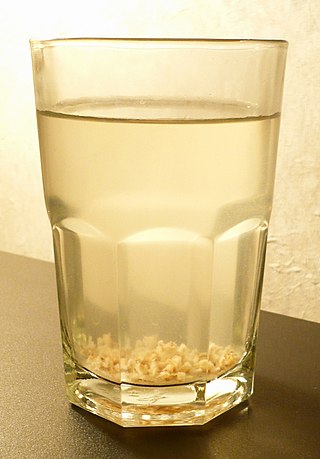
Brown rice tea, called hyeonmi-cha in Korean and nước gạo lứt, nước gạo lứt rang, or nước gạo rang in Vietnamese, is an infusion made from roasted brown rice.

Jorim (조림) is a type of Korean dish, made by simmering vegetables, meat, fish, seafood, or tofu in seasoned broth until the liquid is absorbed into the ingredients and reduced down. Jorim dishes are usually soy sauce-based, but gochujang (고추장) or gochugaru (고춧가루) can also be added, especially when fishier, red-fleshed fish such as mackerel, saury, or hairtail are used. In Korean royal court cuisine, jorim is called jorini (조리니).
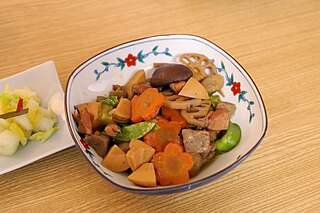
Chikuzenni is a dish that originated from northern Kyushu, Japan, made of braised chicken and vegetables. It is often eaten when bringing in the new year in Japan.

Masala chai (, lit. 'mixed-spice tea', Urdu: مصالحہ چائے, also known simply as chai, is an Indian beverage popular throughout South Asia. Chai is made by brewing black tea in milk and water and then sweetening with sugar. While some variants may also include the addition of aromatic herbs and spices, known colloquially as Masala chai, the most common preparation is unspiced.

Kaiseki (懐石) or kaiseki-ryōri is a traditional multi-course Japanese dinner. The term also refers to the collection of skills and techniques that allow the preparation of such meals and is analogous to Western haute cuisine.

Dried lime tea, also known as chai noomi basra, noomi basra tea or loomi tea, is a type of herbal tea made from dried limes that is traditional to the Arab states of the Persian Gulf and Iraq.
References
- ↑ Sanmi, Sasaki (18 October 2011). Chado the Way of Tea: A Japanese Tea Master's Almanac. Tuttle. p. 42. ISBN 9781462900367.
- ↑ Fieldhouse, Paul. The World Religions Cookbook. Greenwood Press. p. 7.